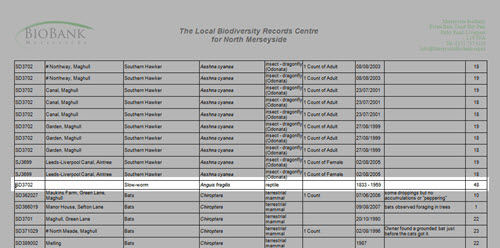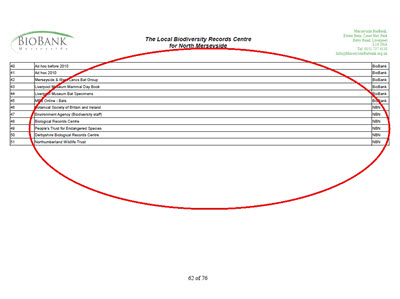Written by Ben Deed
Merseyside BioBank is the Local Environmental Records Centre for North Merseyside. Opened in 2007 the initial project focused heavily on establishing community and education outreach. Designing a building and resources that could be used by schools and new recorders through to experienced naturalists. The legacy of this work still exists today through our local network of naturalist groups, expert recorders and material resources.
Another area of focus has been in the development of systems and services for managing, processing and making available the information provided to us. One of the key functions of MBB is to ensure that environmental information is available and considered during the development process. This is an area in which we can have high impact for the benefit of species conservation, highlight local conservation priorities and can put biodiversity information to work.
While MBB mobilises and holds large amounts of species and habitat information we work as closely as possible with local taxonomic experts, usually representatives of the national societies, to improve confidence in the information held locally. We also recognise the huge amount of information held by the national societies and others. However, where we were unable to make links, this information could not be accessed or considered in general development work or even large scale forward planning and conservation.
With this in mind and many of these expert led organisations now publishing their records via the NBN Gateway we decided to develop systems that could access and incorporate them. The NBN web services were the ideal option.
At the end of 2011 our new reporting program went live and enabled us for the first time to draw down taxon observations using a defined area and serve them up alongside locally held records in a standard report. Since then we have made consistent use of the web services in every standard data request and many non-standard ones.
The initial program was built around the SOAP services and helped us to provide as comprehensive as possible view of wildlife within a search area. In 2015 the service invested in further development work and we now make full use of the REST services through the same desktop based application.
The full integration of local and NBN held information has been welcomed by users as it has simplified the way they can access and view records in a local context and has been built into a product they can make use of. Use of the web services in this way has also saved a significant amount of MBB officer time, ultimately enabling us to provide best available information in a clear and efficient way.
Gateway integration at the click of a button
This is how we incorporated web services into our systems.
The early 'data services' provided by Merseyside BioBank as LERC consisted of the provision of a table of records and some maps produced through GIS work. However, within a few years the service had become more refined with additional context provided all within a far more standardised format.
In 2011 a quantum leap in the LERC reporting system occurred when a new in-house data request utility went live. Working from a series of templates and structured outputs the utility brings together a variety of sources of information to semi-automate the production of a standardised data request report.
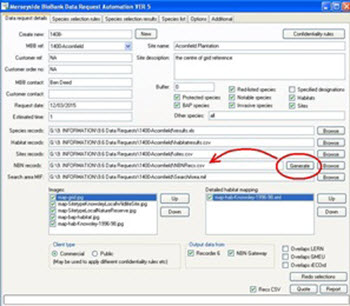
The utility also enables us to access records which we may not hold locally but have permission to use by making calls to the NBN Gateway using the web services and applying our log in credentials. This has helped to fill potential knowledge gaps and so reduce the risk of incomplete information being used to advise development or conservation.
The process is simple, or at least the utility takes the strain!
A GIS layer already produced separately for mapping and querying the Recorder 6 database, is used to query records held on the Gateway (the REST services require that a polygon coordinates are provided as WGS84 while we use EPSG 27700, the utility performs the conversion). Any records found to intersect that search area are then returned via the services.
Once returned the same utility performs a series of marking up and re-formatting tasks to put the records into a useable form. One of these tasks, automatically performed, includes using our Recorder 6 database to provide designations for the species records returned.
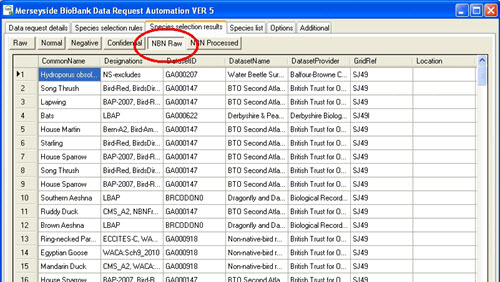
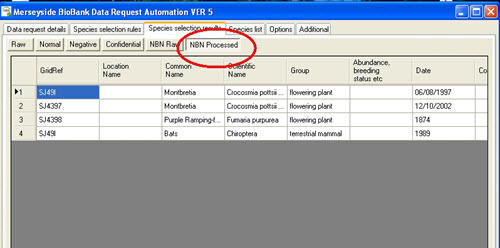
The utility also applies filtering to make the records used in the report as relevant as possible. This includes applying rules such as removing records less precise than 2km square, removal of our own datasets and those of organisations with which we have shared records directly.
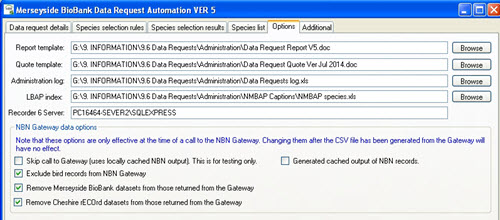
Suitably sorted the report is run and both local and NBN sourced records are seamlessly combined.
The report itself is standardised and includes both summary information and details of the records themselves. In addition, every record used is traceable to its original source. In the case of records that have come from the NBN Gateway, this is the data provider.
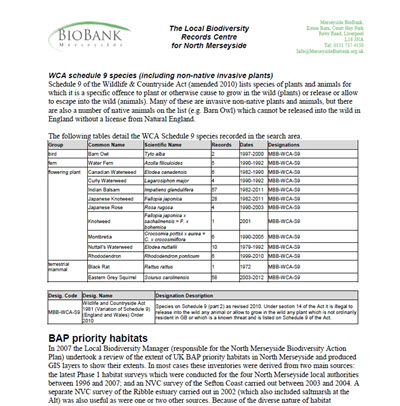
The provider information must be obtained through additional web service calls to the Gateway but these are near immediate. The species record query itself takes very little time with 'large' searches (2km buffers around a site) taking a minute or two. More time is required in post-processing the information but this is minimal with the whole process typically taking a minute.
Because the utility uses our own LERC log in we only access and report on records for which we have been granted permission to use.
